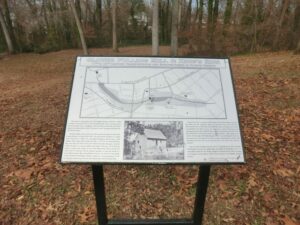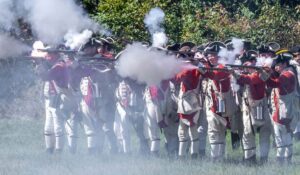Glover Fulling Mill Park

The unusual topography in the McLaughlin-Norcross Dell area of Camden County Park dates to the Colonial period. The steep slopes were related to King’s Run, a navigable waterway that provided the area’s first means of transportation in the 17th Century when European settlement in West Jersey began.
Until the 1920s, a brick and stone mill stood on the opposite side of the stream behind the stage of the Dell. This mill housed machinery to clean cloth and make it thicker by controlled shrinking and beating, called fulling. When John Glover built his mill in 1773-76, he dammed King’s Run and diverted water from just behind the dam through a channel called a head race to run the mill’s waterwheel. The force of the flowing water as well as the weight of the water falling from above turned the wheel and its axle that moved wooden hammers to beat the cloth in a water-filled trough. After being fulled and dyed, the cloth was suspended in open fields for stretching so that it would dry evenly and square. A tale race carried water away from the mill, depositing it back in King’s Run.
Betsy Ross was a customer of the Glover Mill and tradition says that the fabric for the American flag was processed here. The mill was destroyed by fire in 1822 and was rebuilt later that year. However, by the second half of the 19th century, the industrial revolution had begun and steam-powered textile mills had taken over the manufacture of cloth. After the Civil War, the mill quietly passed out of production. The property was sold to the Borough of Haddon Heights in 1911 and although the mill was soon torn down, portions of the tail race, dam embankments, and the mill foundation survive. The current path of the stream reflects the old dam’s location.
You are also standing near the site of a Revolutionary War skirmish with British General Cornwallis after the Battle of Red Bank in 1777. A cannonball found by the Works Progress Administration when creating the Camden County Park in 1937 is now located at the Haddon Heights Library.
39° 52.734′ N, 75° 4.368′ WMarker

